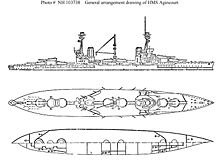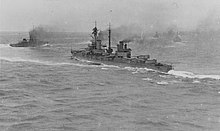HMS Agincourt (1913)
 HMS Agincourt in 1918 |
|
| Overview | |
|---|---|
| Type | Battleship |
| units | 1 |
| Shipyard | |
| Keel laying | September 14, 1911 |
| Launch | January 22, 1913 |
| Namesake | Battle of Azincourt |
| 1. Period of service |
|
| period of service |
August 20, 1914 to 1919 |
| Whereabouts | Canceled due to the Washington Fleet Agreement and scrapped from 1924. |
| Technical specifications | |
| displacement |
27,500 ts |
| length |
204.5 m |
| width |
27.1 m |
| Draft |
8.2 m |
| crew |
1,115 to 1,267 |
| drive |
|
| speed |
22.4 knots |
| Armament |
|
| Armor |
|
The HMS Agincourt was a British battleship during the First World War . As the only battleship in history, the Agincourt had seven main turrets . It was named in memory of the victorious battle of Azincourt .
History of origin
The ship was commissioned by the Brazilian government in 1910 from the British shipyard Armstrong Whitworth in Newcastle upon Tyne . No sister ships were planned. The first two Brazilian dreadnoughts of the Minas Geraes class were built in British shipyards. The ship was intended to preserve Brazilian superiority over Argentina , for which two Rivadavia- class dreadnoughts were started in US shipyards in the same year . It should also be on a par with the Chilean Almirante Latorre class.
Initially, the Brazilian Navy obtained several drafts, which also included plans with a higher caliber . After months of discussion, a design with twelve 356-mm guns and stronger armor was favored and also commissioned. After a change of government, this was canceled and the design with the seven 305 mm twin towers was implemented. In addition to financial problems, the decisive factor was probably that the existing Brazilian dreadnoughts Minas Geraes and São Paulo also used this caliber and that the Imperial Navy still adhered to this caliber.
Construction began on September 14, 1911. On January 22, 1913, the ship was launched as Rio de Janeiro . At the end of 1913, Brazil offered the unfinished ship for sale because the market for natural rubber had collapsed and it was assumed that the ship would not be able to pay for it. The ship was on January 9, 1914 at a price of 2.75 million pounds from the Turkish Navy adopted and under the name I. Sultan Osman continued to be built. The battleship Reshadije was already under construction for Turkey . On August 3, 1914, the Turkish crew should take over the two ships. The day before, however, they were occupied by British troops and confiscated by the Royal Navy . This put Sultan Osman I , ex Rio de Janeiro , into service on August 20 as HMS Agincourt . The Reshadije was named HMS Erin .
From the perspective of the Royal Navy, the ship was already considered obsolete when it was commissioned. The caliber of the main armament was too small, the armor too weak and the number of watertight compartments too small. Because of the many deck openings for the towers, the many magazines and the unusual interior fittings tailored to the hierarchy in the Brazilian Navy, the design of the Agincourt was considered to be quite unfortunate. It was nicknamed "Gin Palace" for the luxurious officers' mess desired by the Brazilians .
The seizure of the two Turkish battleships by the British contributed significantly to the decision of the German government to make the SMS Goeben and SMS Breslau available to the Ottoman Empire. This in turn accelerated the entry of the Ottoman Empire into the First World War on the side of the Central Powers .
Use in the First World War
The Agincourt was initially assigned to the fourth squadron of the Grand Fleet , later it formed together with HMS Marlborough , HMS Revenge and HMS Hercules the 6th Division of the 1st Battle Squadron, with which it took part in the Battle of the Skagerrak . During the battle, she was one of the first ships in Jellicoe's main force to open fire on the German deep-sea fleet . The Agincourt received no hits and suffered no losses. In the course of the battle, she fired several complete broadsides including the middle artillery - there had been rumors that the ship would capsize or tear apart if attempted. A British destroyer commander commented on the sight with the words: “ It was awe-inspiring, looking like a battlecruiser blowing up! ”(German:“ It was impressive, it looked like the explosion of a battle cruiser! ”).
For the rest of the war, the Agincourt took part in isolated advances, but had no more combat contact.
Whereabouts
After the end of the war, the ship was quickly removed from the list of active ships for cost reasons. The Royal Navy offered the Brazilians to buy back the ship after the Navy had carried out various modernizations at its own expense. The boilers were converted to pure oil firing and the horizontal armor was slightly reinforced. The Brazilian government refused in 1921.
Then the plan arose to convert the Agincourt into a depot ship. Five of the seven towers were to be removed and their magazines used to store ammunition. In 1921, the renovation in the Rosyth shipyard should begin. With the conclusion of the Washington Fleet Agreement in February 1922, further use of the ship was prohibited, whereupon the Agincourt was scrapped in Rosyth from 1924.
literature
- Siegfried Breyer: Battleships and battle cruisers 1905–1970. Munich 1970.
Web links
- A somewhat relaxed look at the background story
- HMS Agincourt on worldwar1.co.uk
Individual evidence
- ^ Hugh and David Lyon: Warships from 1900 to today, technology and use . Buch und Zeit Verlagsgesellschaft mbH, Cologne 1979, p. 44 .

